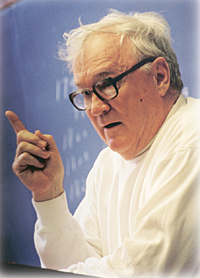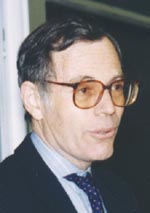
|
REMEMBRANCEMY TEACHER, MENTOR AND LIFELONG FRIENDBy Eric Foner ’63
|
||||||||||||||||||||||||||||||||||||||||||||||||||||||||||||||
|
|
 |
| What makes a
great teacher is a genuine passion for his
subject and the ability to convey that passion
to students. PHOTO: ARNOLD BROWNE ’78 |
I met Jim in the spring of 1961. I was a sophomore who had come to the realization that I was not cut out to be an astronomer. Somehow, I persuaded Jim to allow me to take his Civil War seminar the following year. That class changed my life. It not only made me a historian but introduced me to the period on which my scholarship has concentrated ever since.
Jim already was a legendary figure at Columbia. He did not have a driver’s license, but nonetheless owned a green Triumph convertible. Why? “I never have trouble getting someone to drive me where I need to go,” he explained. His flamboyant lecturing style was famous. Once he donned a raccoon coat and brought a “flapper” to class to enliven a lecture on the 1920s.
But Jim was far more than an entertainer. He demonstrated that what makes a great teacher is a genuine passion for his subject and the ability to convey that passion to students. Throughout his Columbia career, he also taught at Montclair College, Manhattan School of Music and Katherine Gibbs secretarial school, not for the money, but because he loved teaching. He brought history to television in the 1960s, delivering a lengthy course of lectures on public television. One of his admirers was my dentist, who made audio tapes of Jim’s TV course, which he would play while drilling.
Jim was something of an outsider in the history department, as he never involved himself in committee work and published fewer academic books than many colleagues. But he knew his history and read voraciously. When I first met him, he taught a different history from the bland consensus vision that then dominated scholarship, offering sympathetic accounts of America’s underdogs and visionaries. Jim connected the past to the present, helping us understand the deep historical roots of the racial crisis engulfing the country.
Jim stood out as the conscience of the Columbia
faculty. His was a personal radicalism, resting
on the primacy of individual conscience and abhorrence
of violence rather than membership in any political
organization. During the 1960s, Jim helped to organize
an expedition of Columbia students to Orangeburg,
S.C., for a voting rights campaign. In subsequent
decades, he lent support to students demanding that
Columbia “divest” from South Africa
and to clerical workers seeking to force the University
to recognize their union.
In 1968, Jim was one of the few faculty members
who maintained sympathetic ties with the protesting
students, many of whom had taken his classes. He
was trusted by white and black demonstrators. With
a few other teachers, he positioned himself outside
one of the occupied buildings to prevent violence.
When the “bust” came on the night of
April 30, 1968, Jim was one of hundreds of persons
injured by the police.
I was then a married graduate student working on my dissertation; I supported the protesters’ demands but was not in a building. That night, my wife and I found Jim on campus, brought him back to our small apartment, and treated his wounds as best we could. The next day, his arm in a sling and his head bandaged, Jim was interviewed by NBC Nightly News. In the midst of recounting what he had seen, he stopped and began crying.
Those who knew Jim will not be surprised that many of my memories of him involve food. That first seminar provided not only a wonderful intellectual experience, but also an introduction to New York’s culinary delights. Each week, Jim took three students out to dinner to prepare discussion questions for the next session. “Never let a student pay for a meal,” he once advised me, a rule I have tried to follow (at least until they obtain their Ph.D.s).
As I got to know Jim better, I came to marvel at his love of food and knowledge of it. (Not many people realize that his publications included an Italian cookbook.) His famous walking tours of New York neighborhoods always left time for stops at bakeries and delicatessens.
Jim and his nephew, Guy, met me in Ireland in 1973 to tour the country. He loved Ireland, but found the food wanting. Finally, in the small town of Newport, we chanced upon an inn where several cars with French license plates were parked. “Let’s eat there,” he exclaimed. “The French aren’t having boiled potatoes.” Sure enough, it was the best meal of our trip.
Jim was the most loyal of friends to my family. He persuaded my father, a history teacher blacklisted for many years because of his political beliefs, to complete his long-abandoned doctoral dissertation. (“You can’t let your son get his Ph.D. before you do,” he said.) When I married for a second time in 1980, Jim ordered the wedding cake from Caffe Roma in Little Italy and carried it on his lap in the back seat of my car, imploring me not to hit any potholes as we drove to the party.
When my daughter, Daria, was born, we asked Jim to be her godfather. “Uncle Jim” certainly took to the role. Every November, he told us to let her design a birthday cake at a fancy Madison Avenue bakery and send him the bill. Over the years, Daria has had cakes decorated with a merry-go-round, roses, a frog and even a giant ballet tutu made of spun sugar.
What really stands out in memory is Jim’s love of life and generosity of spirit. He wanted to make people happy and teaching was one of the ways he did so. If there’s a heaven, I’m sure Jim has already located the finest bakeries and is giving lectures and leading walking tours for the angels.
|
|
 |
| PHOTO: JOE PINEIRO |
Eric Foner ’63 specializes in the Civil War, reconstruction, slavery and 19th-century America. He received his Ph.D. from Columbia in 1969 and has been widely published. In 2000, served as president of the American Historical Association.
| || | || |
CCT Home |
|
|
|
|
|
CCT Masthead |